| |
Macau
Driven mainly by commercial motives, Portuguese explorers in the 15th and 16th centuries sailed down the coast of Africa and across the Indian Ocean to get direct access to the spices of Southeast Asia and the luxury goods of the Orient. By the mid 16th century, the Ming government realized that reviving trade along the southeast coast would improve prosperity and tax income. In 1557 the Ming granted the Portuguese a license to trade at the city of Macau, located on a small peninsula on the south China coast, close to the major provincial city of Canton. (Macau is the official modern spelling; Macao is an older English spelling). Macau had a warm climate, an attractive beach, a good harbor, and an excellent location for trade. It prospered in the 16th and 17th centuries, but declined as a major trade port after the rise of the Canton system. The Portuguese, however, held it as a colony until they returned it to China in December, 1999.
|
|
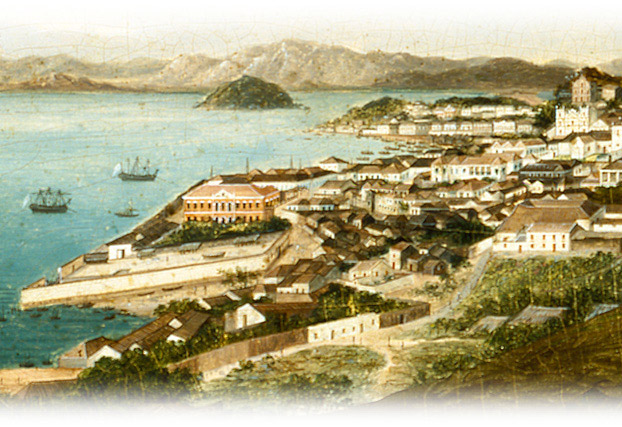 |
| |
The bay of Macau, located at the mouth of the Pearl River, can be seen in this landscape. In 1557 the city was leased to the Portuguese, who helped to restore the export of Chinese silk to Japan after China had closed its ports to the Japanese due to the threat of multi-racial pirate raids.
“Macao, View of Two Bays, ca. 1830”
Unknown Chinese artist
Peabody Essex Museum [cwM_1830c_M975102]
|
|
| |
As a Portuguese colony, Macau was the only location in China where Westerners and their families could live year-round. For the four months of the trading season merchants were allowed to reside up-river at Canton, though no women were allowed. Macau offered a lively social life and diverse population intermingling Westerners and Chinese. Its area of 23.5 square kilometers included granite hills topped by fortresses, whitewashed Portuguese churches, trading houses, and residences, and was known in many artworks by the distinctive crescent-shaped Praya Grande beach.
|
|
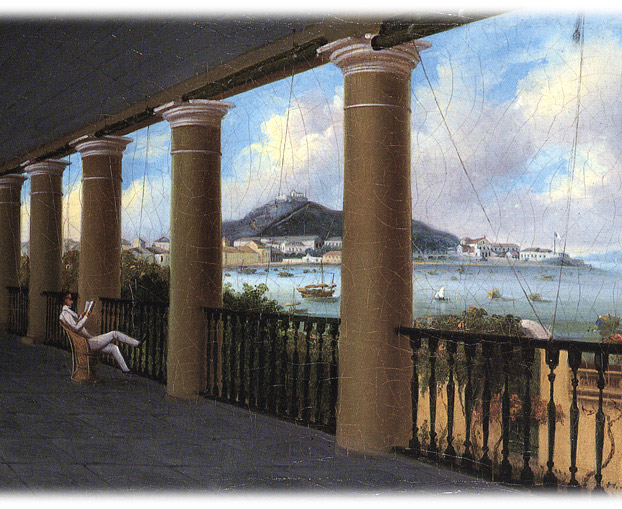 |
| |
Macau was the most European of the Pearl River cities, described as a “good Portuguese town” with whitewashed churches and western-style homes. The Praya Grande beach—seen here from Nathan Kinsman’s veranda—became its most famous view. Merchants were permitted to reside in Macau with their families year-round. Kinsman’s wife, Rebecca, kept a detailed journal of her experiences in China.
“Veranda of Nathan Kinsman’s residence in Macau,” ca. 1843
by Lam Qua
Martyn Gregory Gallery [cwM_1843c_KinsmanPorch_ct94]
|
|
| |
The “Paradise of the East”
Macao from the sea looks beautiful, with some most romantic spots. We arrived there about ten o’clock, took sedan chairs and went to our house, which we liked the looks of very much. The streets of Macao are narrow and irregular, but we have a garden in which I anticipate much pleasure. [Harriet Low’s journal, September 30, 1829]
Harriet Low, a twenty-year-old girl from Salem, Massachusetts, arrived in Macau on September 29, 1829, with her aunt and uncle. As one of the few young women in the foreign community, she soon became acquainted with many of the prominent men of the town. Her lively letters and insightful journal provide vivid pictures of the interactions of foreigners and Chinese in Macau. She met the hong merchant Mouqua, “a great character...very gallant,” sat for her portrait by George Chinnery, and attended many balls, dinners, and parties. Sprightly and inquisitive by nature, she found herself frustrated by the confinement of foreigners and by the frivolousness of the young Englishmen. “The men are a good-for-nothing set of rascals. ...all they care about is eating, drinking, and frolicking.”
|
|


Harriet Low (1809–1877) left for China with her aunt and uncle at the age of 20, and stayed in Macau from 1829 to 1833. She made a secret visit to Canton, which caused a diplomatic crisis, and posed for this portrait by Chinnery, dressed in the latest fashions brought from Calcutta, with sleeves stuffed with down pillows. She commented on her dress, “Such sleeves I never beheld—complete frights!”
(Harriet Low’s journal, August 18, 1830)
“Harriet Low,” 1833
by George Chinnery,
[cwPT_1833_HLow_Chin_PE25246]
|
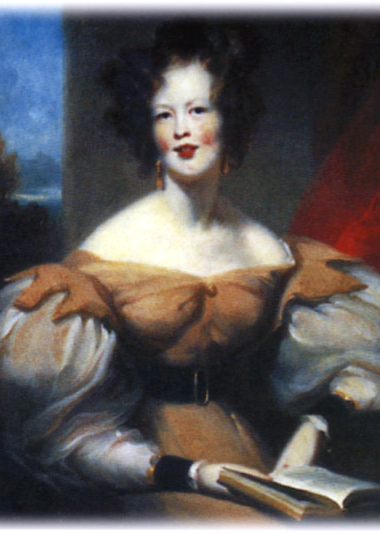 |
| |
Miss Low longed to visit Canton, the truly Chinese city up the river. Although the Chinese banned all foreign women from Canton, several Englishwomen had secretly made the trip. She and her aunt embarked in November 1830, dressed as boys, and walked straight into the American factory. As they walked up and down Old and New China streets, the Chinese stood staring at them quietly, until sailors drove the crowds away. When the Chinese authorities threatened to shut down all trade if the ladies did not leave, they had to go. Harriet’s adventure showed that the Chinese still controlled foreign access to Canton; as she said, “The Chinese are very cunning, and know very well what they are about.”
Harriet Low often heard sermons by the pioneering Scottish missionary Robert Morrison, and knew the medical missionary Thomas Colledge:
Have been to church this morning, my dear, and heard an excellent sermon read by Dr. Morrison. The subject was that the chief end of our existence was to do good, certainly not to enjoy, for the trials and troubles we are subjected to in every stage of life prove that. I thought his reasons and arguments very good, but, if this is the purpose of our existence, how few fulfil it! ... I know one person here who does, and that is Mr. Colledge. He is continually going about doing good; he makes every one love him, he is so universally kind and obliging, and exerts himself to make all happy who come in his way. We call him "the sunbeam," for everything smiles when he approaches. His greatest pleasure is in doing good, and his face speaks the goodness of his heart. [January 6, 1833]
Robert Morrison arrived in China in 1807 and stayed there for nearly 27 years. As the first Protestant missionary in China, he faced heavy opposition from the resident Catholics as well as imperial officials, who tried to prevent him from learning the Chinese language. But he persevered on his own, obtaining a post as translator for the East India Company, which allowed him to live in Canton while his wife stayed in Macau. The foreign merchants appreciated his skills, but when he began translating Biblical texts the Qing government declared it a capital crime to publish Christian books in Chinese. Still, Morrison produced on his own a translation of the Bible into colloquial Chinese and the first Chinese English dictionary, after 16 years of work, distributing them secretly with Chinese helpers. He also founded both a dispensary to give ordinary Chinese effective Western medicines, and the Anglo Chinese college at Malacca. He trained several Chinese assistants to carry on his work, creating a small Christian community. Morrison died in 1834 and was buried in the Protestant cemetery in Macau.
|
|
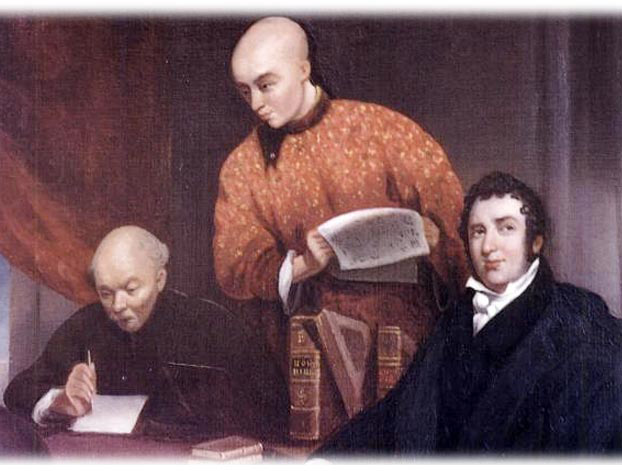 |
| |
Defying Chinese government prohibitions, Robert Morrison, the first Protestant missionary in China, learned Chinese and hired assistants to help translate the Bible into Chinese and produce the first Chinese-English dictionary.
“Dr. Morrison Translating the Bible,” 1830
by George Chinnery
[cwPT_1830_morrison]
| |
| |
In Macau, Harriet Low became a good friend of Dr. Thomas Colledge, one of the first Western medical men to practice on Chinese patients. While an employee of the British East India Company, he set up an ophthalmology clinic in 1827 in Macau, specializing in the removal of cataracts, and treated over 4000 patients during his time there.
|
|
| |
“Dr. Colledge’s Eye Hospital,” 1838
by George Chinnery
Medical History Library, Yale University [cwM_1838_ColledgeClinic]
| |
| |
In his studio, Harriet saw Chinnery’s most famous picture, which portrays Dr. Colledge after he has restored the sight of a nearly blind Chinese woman. Colledge rests his hand on the woman’s forehead, lifting her eyeglasses and asking his servant to interpret for him. The woman’s son, with the long queue, kneeling in front of him, presents a red envelope containing a letter of thanks. In the far left, an old man kneels with his eyes bandaged waiting for treatment. Harriet Low was shocked by the large number of blind beggars she saw on the streets. Seeing a blind man, she “could not help asking myself what feeling or principle he could have within that could induce him to bear such loads of misery.”.
| |
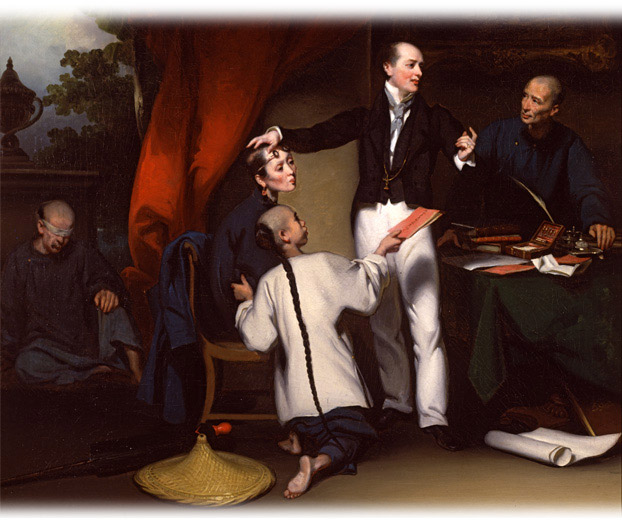 |
| |
Dr. Colledge’s eye clinic in Macau was the first medical service run by a Western doctor for Chinese patients. This famous portrait by Chinnery shows the doctor after he has completed an operation on a Chinese woman, explaining the outcome to his servant, who acts as an interpreter. The woman’s son kneels in front, presenting a letter of thanks. Chinese officials opposed the influence of foreign missionaries who had only religion to offer, but they encouraged those who brought knowledge of useful arts such as medicine or weaponry. After Colledge, the Yale graduate Peter Parker continued his medical and missionary work in Canton.
“Dr. Thomas Colledge with Patients,“ ca. 1833-1835
by George Chinnery
Peabody Essex Museum [cwPT_1833-35_M23017]
|
|

Visualizing Macau

|
| |
Although Macau never attained the commercial importance of Canton and, later, Hong Kong and Singapore, artists like Chinnery and his compatriots, disciples, and successors succeeded in conveying a sense of human vitality often lacking in depictions of the more thriving treaty ports. Vignettes of the city and surrounding countryside include native people as well as foreigners, and convey at least a general impression of life beyond the foreign community—temples and crowded public places, for example, as well as the back alleys of Macau.
|
|
| |
Chinnery documented the ordinary life of Macau in paintings and sketches. In this view of the Praya Grande, he places the Chinese boat people in the foreground against the backdrop of the foreign buildings.
“The Praya Grande, Macau,” 1825–1852
by George Chinnery
Hong Kong Museum of Art [cwM_1825-52_AH6410]
|
|
| |
Many forts topped the mountains around Macau—here, Fort Guia and Monte. Built by the Portuguese for defense against pirates in the sixteenth century, by the 19th century these had become mere backdrops for scenic excursions. The funeral depicted is likely a Chinese ceremony as they preferred to bury their dead on hillsides, where the fengshui, or geomancy, was more favorable. The hand coloring, however, is inaccurate—black and red were not worn in funeral rituals.
“Macau from the Forts of Heangshan,” 1839 & 1842
published in Borget’s Sketches of China and the Chinese
Hong Kong Museum of Art [cwM_1839-42_AH8821]
|
|
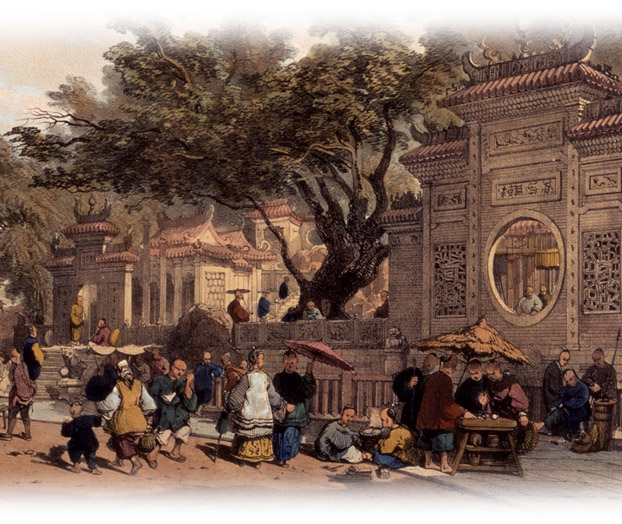 |
| |
This Chinese temple was dedicated to Amagao (Mazu in Chinese), the Queen of Heaven and patron goddess of sailors of the south coast, for whom the Portuguese named the city of Macau. Chinese residents are gathered here for family outings, gambling, tea, fortune telling, and worship.
“The Square Outside the Ma Kok Temple,” 1838
Drawn from nature by Aug. Borget, lithograph by Eug. Ciceri
Hong Kong Museum of Art [cwM_1838_AH643329]
|
|
| |
Another view of the Ma Kok temple was made from the riverside by William Heine, who contributed several evocative sketches of Macau when the Perry expedition to Japan made stops in China.
“Chinese Temple in Macau,” 1853
by William Heine
Perry’s Narrative of an Expedition [cwM_1853_Heine_Temple_bx]
|
|
| |
Heine drew a romantic view of the Praya Grande crescent illuminated at sunset, with women in white, possibly Western Christians visiting a grave.
“Macao From Penha Hill,” 1854
by William Heine
Perry’s Narrative of an Expedition [cwM_1854_Heine_Macau_bx]
|
|
| |
One of the most famous sites in Macau was the subject of another Heine view: St. Paul’s church, built in 1582 for the Jesuits, burned in 1835 and only its facade remains. Japanese Christians expelled from Japan carved its stone facade.
“The Facade of St. Paul’s Church, titled ‘Jesuit Convent, Macao,’” 1854
by William Heine
Hong Kong Museum of Art [cwM_1854_AH644191]
|
|
| |
Chinnery also did sketches of the back streets of Macau, which depict the everyday life of the local people. He showed peddlers, porters, food shops, and others resting in the shade behind the St. Dominic’s church.
“Macao Street Scene,” 1840-45
Watercolor on paper, by George Chinnery
Hong Kong Museum of Art [cwM_1840-45_M381084]
|
|


|
| |
Chinese artists followed the tradition set by Chinnery and Heine, continuing to paint Macau into the 19th century. Panoramic views from the hills included all the famous landmarks of the city: the Church of St. Paul’s facade, the Church of St. Lawrence, the Praya Grande lined with shops, and fleets of ships, Western and Chinese in two bays. The town continued to grow in the 19th century, even though the opening of treaty ports in China took away its special character, and the focus of Western traders turned to Canton, Shanghai, and other large cities.
|
|
| |
Macau ca. 1870
A sweeping overview of Macau shows that the quiet town has grown into a built-up city by 1870.
“Panoramic View of Macau from Penha Hill,” ca. 1870
Unknown Chinese artist
Hong Kong Museum of Art [cwM_1870_AH831]
|
|
|

